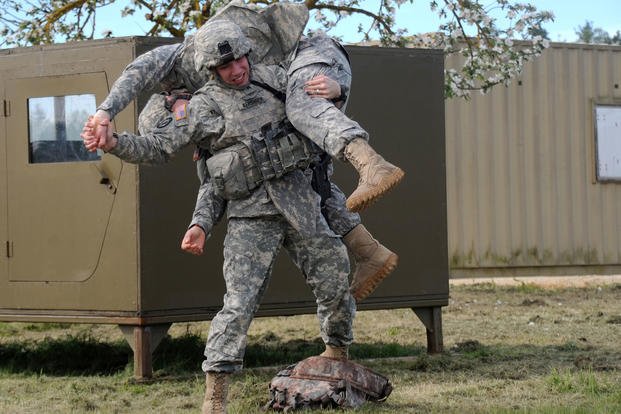Whether you are a civilian, active duty or a candidate preparing for military, police or firefighter training, there are some valuable skills you learn and abilities you maintain when you test yourself regularly with some form of a fitness test.
This does not have to be a normal PT test of push-ups, sit-ups and a run. But assessing your abilities regularly can help you one day, when needed, to save yourself, your family, your teammates or other people caught in dangerous situations.
For instance, take on-the-job dangers that occur for the tactical professional. Being fit is a prerequisite to obtain a job as a military person, police officer and firefighter, but maintaining it is often not enforced to the degree that is helpful.
If you are a candidate seeking employment in the tactical professions, the testing and training preparation alone will help you obtain a higher-than-average level of fitness. And if you are a civilian, just the recent natural disasters of storms, floods or fires should make you realize that you will see two types of people in rescue situations:
- Those who can help
- Those who need help saving themselves
The Fitness Test Dilemma
By no means is training solely for a fitness test a way to go. Where many people make the mistake is training for the lowest levels to pass a test -- only training for a few weeks a year to achieve those scores.
Minimal standards on typical fitness tests basically determine that you are healthy enough to wear a uniform, but they have little to do with your abilities to be a good soldier, police officer or firefighter.
Higher levels of fitness, however, will improve your chances of helping yourself and/or others when in a desperate situation. At the same time, higher fitness levels are not the only determining factor to being a good soldier, police officer or firefighter.
All of these are critical skills and abilities:
- Grip strength
- Arm and leg strength
- Running speed
- Swimming abilities
- Lower-back strength
- Load-bearing ability
We must have the ability to help not only ourselves but others, if necessary.
Tips for Assessing Your Tactical Abilities
Here are some ways to incorporate testing elements into your regular workout routine:
During the Run
If you are using running as a cardio event for your workouts or testing protocol, try to mix in some timed distances (one mile, 1.5 miles, shuttle runs, 400-meter sprints). From longer timed runs to shorter sprints with some agility training, these will help you maintain needed speed and endurance when running from danger. These timed assessments can help you determine whether you need to improve your game with future workouts for speed or endurance.
Cooldown with Swimming and Pool Skills
Getting in the pool at the end of a workout can be quite refreshing. Practicing the ability to swim, tread and float are also good skills to have, in case you have to help people or yourself caught in dangerous situations in water. If you need lessons, get them. Being ineffective on 75% of the Earth is no way to go. Swimming is a survival skill.
Lift Your Body Weight or Lift and Drag Others
Whether lifting your body weight from the ground (deadlifts) to over your head (pull-ups/push presses), pushing or pulling is a critical skill to get up and over obstacles to safety.
Carrying heavy objects like sandbags and walking with dumbbells can build stronger legs, back and grip to get the task done when carrying a stretcher or someone over your shoulder. They do not call it the fireman carry for nothing; those of you in that business need to practice that movement. Also dragging or pushing sleds, sandbags or people while crawling or standing is a tactical movement that saves lives and requires significant grip, core and full-body strength.
Having a program of lifting weights and flipping tires can also help you develop this type of strength and ability.
Higher-Repetition Testing/Calisthenics
Sometimes saving yourself or others means high-repetition movements while carrying or lifting light weight. Higher-repetition calisthenics testing can help you maintain and develop the muscle stamina needed for long hours of lifesaving work, if needed.
Keep Performance High and Body Fat Low
As we age, outworking our diet becomes an impossibility. Gaining too much weight year after year has a way of affecting job performance if you do not stay on top of your food intake and fitness output. For the person over 40, check out Tactical Fitness For the Athlete Over 40 for ways to incorporate more mobility and longevity to your training. Even for the civilian, tactical fitness or a program, such as the PFT Bible, is ideal for getting started with training that one day can save your life or the lives of others around you.
Related articles for training:
- To and Through Training
- Operator Grip
- Mobility Day Off -- Longevity and No Pain
- Classic Week of PT/Cardio
- Tactical Fitness -- Regular Fitness Comparisons
Stew Smith is a former Navy SEAL and fitness author certified as a Strength and Conditioning Specialist (CSCS) with the National Strength and Conditioning Association. Visit his Fitness eBook store if you're looking to start a workout program to create a healthy lifestyle. Send your fitness questions to stew@stewsmith.com.
Want to Learn More About Military Life?
Whether you're thinking of joining the military, looking for fitness and basic training tips, or keeping up with military life and benefits, Military.com has you covered. Subscribe to Military.com to have military news, updates and resources delivered directly to your inbox.


















